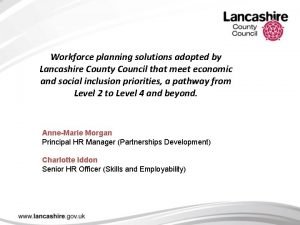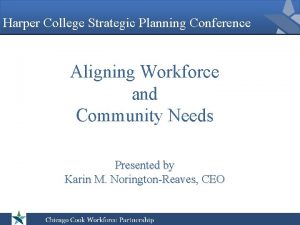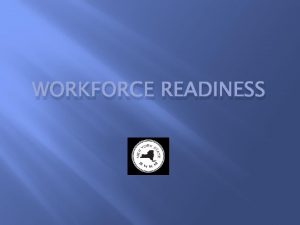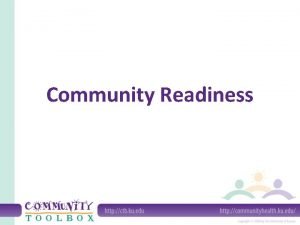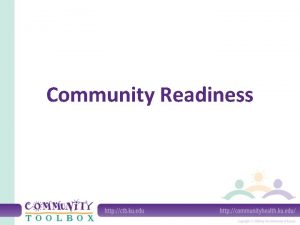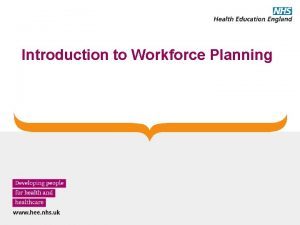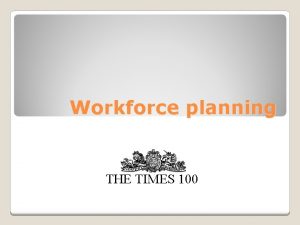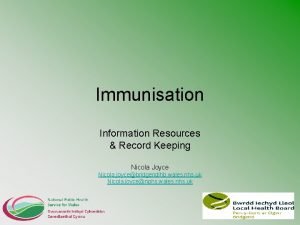Digital Readiness Planning for our future workforce Nicola




















































- Slides: 52

Digital Readiness Planning for our future workforce Nicola Calder, Digital Readiness, Workstream Lead

Agenda • Introduction: Digital Readiness – Workforce Planning (Nicola Calder) • Project 1: Current workforce national workforce data collection – purpose and benefits to end user (Chris / Di) 10 minutes • Project 2: Future Workforce (strategic workforce planning): Forecasting future demand (Rupert and Don) 20 - 25 minutes • Questions

Delivery Programme: Digital Readiness (Building a Digital Ready Workforce )

4 Delivery Programme: Digital Readiness (Building a Digital Ready Workforce )

Planning for digital: Theory of Change @NHS_Health. Ed. Eng #BDRWFuture. Workforce


NW Skills Development Network Workforce Profile 2020 Christine Banks NW Informatics Skills Development Manager Di Ormandy Head of NW Skills Development Network Developing Today to Influence Tomorrow. . . 7

Overview • NW Informatics Skills Development Network- a very brief summary • History of the workforce profile • Benefits to our members • What and how we are collecting information Developing Today to Influence Tomorrow. . . 8

ISDN – membership network 1. Learning and Development 2. Sharing best practice and networking 3. NW Informatics Awards 4. Annual Workforce profile 5. Excellence-in-Informatics Accreditation (including Digital Maturity Assessment) 6. Informatics Skills Framework 7. Professionalism Developing Today to Influence Tomorrow. . . 9

Annual Workforce Profile Completion during July and August each year as 30 th June 1 st census collated 2011 Baseline = roles from www. hicf. org. uk Refined over the years Not perfect – but a great start! Informatics staff in all NW organisations • what areas of informatics they work in • what banding • highest level qualifications they hold • whether they are members of professional bodies • Not currently - age / ethnicity Developing Today to Influence Tomorrow. . . 10

What does it look like? Developing Today to Influence Tomorrow. . . 11

What’s in it for you? As a leader you will be able to: • Understand what your workforce looks like (across all disciplines of Health Informatics) • Biggest & most expensive resource / greatest asset • Manage transition into the new land scapes • Identify gaps and overlaps • Deploy skills and competencies flexibly • Plan staff development effectively • Measure and evaluate change/progress Developing Today to Influence Tomorrow. . . 12

Quote from stakeholder I joined my organisation following a period of upheaval, as they had been through a recent acquisition of another mental health provider and were still in the forming stage as a new organisation. The IM&T team at the time I joined was made up of groups of staff from the 2 previous organisations who had come together but had not gone through any proper restructuring to form a cohesive unit, fit for purpose for the new organisation. I found the benchmarking information that was available from the ISDN invaluable, in giving me a clear view as to the structure that would be required to support the new organisation. It was helpful in identifying skill mix, numbers and grades of staff that would be optimum for an organisation of our size. Without the benchmarking information, I would have had difficulty in providing some of the evidence base that was required to gain support for the new structure. Grace Birch Associate Director of IM&T Greater Manchester Mental Health NHS Foundation Trust Developing Today to Influence Tomorrow. . . 13

Benefits to Member Organisations § Agreement to share data between member organisations § Need to understand whole picture around data § Ways to use data: ü Benchmarking whole organisation ü Benchmarking parts e. g. grades/roles etc. ü Collaboration in a local foot print § Mapping the development of the informatics workforce • Directors • CCIOs § Enables focused learning and development on specific workforce issues Developing Today to Influence Tomorrow. . . 14

Quote from stakeholder cont. As you know I am trying to get time to use the data for an overall review of the digital workforce in C&M. Whilst it is early days I believe we have the source of data to start working on a joint plan for digital workforce development. We have also used it as a basis for an initial review of Cyber skills and as you know we are now building on the original data for a further more in depth view of cyber skills across the North West. In my previous role as CIO at WUTH we used it frequently when reacting to requests for more resources to adjust to new workloads in specific areas such as BI analyst, Clinical coding and developers. Paul Charnley Digital Lead Cheshire & Merseyside Health & Care Partnership Developing Today to Influence Tomorrow. . . 15

Total Staff Headcount 2017 2018 2019 Staff (Headcount) 4618 4580 5072 Agency Staff 202 106 105 WTE 2017 2018 2019 Total Establishment 4463. 32 4449. 01 4996. 49 Total Staff in Post 4196. 59 4265. 58 4739. 47 Vacancies 266. 73 183. 43 257. 02 Vacancy Rate 5. 97% 4. 12% 5. 14% NB: All above figures exclude partial returns Developing Today to Influence Tomorrow. . . 16

Headcount by Band Senior Band 9 Band 8 d Band 8 c Band 8 b Band 8 a Band 7 Band 6 Band 5 Band 4 Band 3 Band 2 Band 1 Apprentices Other Agency Seconded 0 Seconded Agency 2018 2019 24 16 105 Other 17 6 200 Apprentic Band 1 es 24 3 27 6 Band 2 201 225 400 Band 3 466 505 Band 4 600 Band 5 Band 6 Band 7 728 750 1022 1089 826 944 685 765 800 Band 8 a Band 8 b 335 429 121 158 Band 8 c 46 56 Developing Today to Influence Tomorrow. . . 1000 Band 8 d 13 22 Band 9 4 7 1200 Senior 89 83 17

Headcount by Role (Information) 600 500 400 300 539 469 200 297 326 320 216 100 234 169 108 172 107 45 0 Technical Data Manager/ Data Repository Data Analyst Business Intelligence Data Quality 2018 Clinical Coding Information Governance 42 Database Administrator 22 15 Web Development 2019 Developing Today to Influence Tomorrow. . . 18

Chief Clinical Information Officers 2017 2018 2019 Number of organisations without a CCIO 22 15 19 Total number of organisations with at least 1 CCIO 34 37 38 Total number of CCIOs 52 51 63 Organisations with more than 1 CCIO 2019: Organisation No. of CCIOs Manchester University NHS Foundation Trust 9 East Lancashire Hospitals NHS Trust 6 Salford Royal NHS Foundation Trust 5 Bolton NHS Foundation Trust 4 Alder Hey Children's NHS Foundation Trust 3 NHS Morecambe Bay CCG 2 The Christie NHS Foundation Trust 2 Wrightington, Wigan and Leigh NHS Foundation Trust 2 Developing Today to Influence Tomorrow. . . 19

Qualifications Level 7 Post Graduate/Masters Learning including credits towards these qualifications Level 6 Degree Level 5 Foundation Degree Level 4 Certificate of Higher Education Level 3 2 x A Level (Grades A - C) or equivalent level of qualification Level 2 5 x GCSEs (grades A - C) or equivalent level of qualification Level 1 GCSEs (grades D-G), BTEC Introductory Diplomas and Certificates, OCR Nationals or equivalent level of qualification Based on the National Qualifications Framework (NQF) Developing Today to Influence Tomorrow. . . 20

Qualifications Please note, not all organisations submitted qualifications data. 7 Post Graduate/Masters 6 Degree 5 Foundation 4 Cert. of Higher Education 3 2 x A Level (Grades A - C) 2 5 x GCSEs (grades A - C) 1 GCSEs (grades D-G) 0 2019 2018 2017 1 152 101 482 200 2 744 459 1016 400 2017 - 3604 staff of 4618 3 478 415 263 600 4 634 519 485 800 Totals: 2018 – 3129 staff of 4580 5 269 227 525 1000 6 1226 975 694 1200 7 589 433 139 1400 2019 - 4092 staff of 5072 Developing Today to Influence Tomorrow. . . 21

Professional Bodies 2018 (4580 staff) 2019 (5072 staff) 86 21 N/A 4 N/A 95 N/A 4 N/A 55 26 32 0 0 Chartered Institute of Personnel and Development (CIPD) 5 5 Association for Project Management (APM) Institute of Health Records and Information Management (IHRIM) Relevant clinical professional body 20 18 38 66 102 110 Other 148 181 Professional Body BCS ASSIST FEDIP UKCHIP APHA Chartered Institute of Library and Information Professionals (CILIP) Learning and Performance Institute (LPI) TOTAL Developing Today to Influence Tomorrow. . . 450 566 22

NHS Digital Technology and Health Informatics Workforce: Current Supply and Future Demand Forecasting - 2020 to 2030 Don Liu and Rupert Milsom National Workforce Planners HEE Workforce Planning and Intelligence Directorate

Six Steps Methodology to Integrated Workforce Planning 1. Define the plan 2. Map service change 3. Define the required workforce 4. Understand workforce availability 5. Develop action plan 6. Implement, monitor and revise

NHS Digital Technology and Health Informatics: Current Workforce Size HEE Phase 1 Project Report (December 2019)1 • Workforce observed in nine relevant occupational categories (areas of work) in the NHS Electronic Staff Record (ESR) dataset • 17% increase over five years or 3. 4% increase on average per year – 2014: 29, 739 FTEs – 2019: 34, 754 FTEs • Workforce Estimation differ considerably – National Information Board ~ 47, 000 (HC) – The Health Foundation ~ 44, 500 (WTE) – Department of Health and Social Care ~ 60, 000 (HC) 1. https: //www. hee. nhs. uk/our-work/building-digital-ready-workforce

NHS Digital Technology and Health Informatics: Current Workforce Size – “The Denominator” Function Organisation Size Staff Distribution 44, 666 FTE Composite Index based on “UK Tech Innovation Index”

NHS Digital Technology and Health Informatics: Current Establishment Size – “What Good Looks Like” • The Digital Maturity Assessment (DMA) measures how well secondary care providers in England are making use of digital technology (Readiness, Capabilities & Infrastructure) • Using the 2017 DMA scores, the 38 highest performing trusts have been deemed "Good" for the purpose of this work. • A blue print for a high performing digital workforce that was then used as a proxy for establishment.

Data Definitions • Project Supply– Estimated future supply based on the assumption that trends observed in the past will continue. • Population based Demand – Estimated future demand based on projected population growth applied to previously established workforce blue print. • Prevalence based Demand – Estimated future demand based on projected changes in population demography applied to previously established workforce blue print.

Projected Supply and Workforce Size - Next 10 Years NHS Digital Technology and Health Informatics – Project Supply Is this increase or rate of increase enough to meet service needs over the next 10 years?

Projected Supply and Workforce Size - Next 10 Years 1. 1. Clinical Coding – 4. 2%

Projected Supply and Workforce Size - Next 10 Years 1. 2. Health Records – 0. 5%

Projected Supply and Workforce Size - Next 10 Years 1. 3. Information Management – 0. 01%

Projected Supply and Workforce Size - Next 10 Years 2. 1. Information and Communication Technology – 4. 65%

Projected Supply and Workforce Size - Next 10 Years 3. 1. Clinical Informatics – 6. 3%

Projected Supply and Workforce Size - Next 10 Years 3. 2. Knowledge Management – 4%

Projected Supply and Workforce Size - Next 10 Years 4. 1. Programmes and Project Management – 10%* N. B. Flow analysis using HEFT suggests a 24% increase in the programmes and projects workforce per annum. This is considered to be an overestimate due to how the methodology of HEFT is affected by the implementation of new categorisations. For the purpose of this assessment growth is limited to be 10%

Projected Supply and Workforce Size - Next 10 Years 4. 2. IT and Informatics Strategy and Development – 2. 4%

Projected Supply and Workforce Size - Next 10 Years 4. 3. IT and Informatics Education and Training – 2. 6%

Six Steps Methodology to Integrated Workforce Planning Step 3 Define the Required Workforce Identifying the workforce needed to deliver reconfigured services: • Skills needed • Types of staff required • Numbers of staff required Workplace demand = Right types and right numbers of staff with the right skills needed

Scenario-based Workforce Planning Method used to encourage stakeholders to think how work and working practices might change in the future and how they will need to respond to these changes. HEE Strategy Team. Scenario Development (Version 1). 2020 Scenario planning looks ahead at alternative views of the future…and identify workforce gaps against future needs. These include positive gaps (more staff needed), negative gaps (less staff needed) and gaps in skills but not in numbers (staff need to be retrained). CIPD. Workforce Planning Practice: Guide. 2018 Defining the required NHS digital technology and health informatics workforce in 2030 – key elements to the approach: • Scenarios: HEE to set out two alternative visions of what the future will look like in 2030 for this workforce – Scenario A: Data Driven Future and Scenario B: Data Desert Future • Typical NHS acute NHS trust: HEE to describe and set out the current (2020) workforce size in the nine ESR areas of digital technology and health informatics work – the benchmark data • Forecast future demand: Require expert and informed judgements from stakeholders in projecting future demand types of staff and skills needed in each of the nine areas of work

Scenario A and B Development: Methodology 3 Steps: 1. Royal Society for the Encouragement of Arts, Manufacturers and Commerce (RSA) Four Futures of Work programme • Examined scenarios developed by the RSA • Based on a strong evidence base • Focussed on the future role of workers in all sectors 2. HEE Future Doctor programme • Using the RSA scenarios to develop four healthcare futures – what healthcare will look like in the next 10 to 15 years • Developed and stress-testing through workshops with healthcare leaders 3. HEE Digital Readiness: Supply and Capacity programme • Workshops with representatives and leaders of different sectors of the healthcare digital technology and health informatics sectors • Used the Future Doctor programme scenarios to identify key drivers expected to influence the development of the digital technology and health informatics workforce • Identification of drivers used to produce two alternative scenarios – A. Data Driven Future 2030 and B. Data Desert Future 2030 – in order to make forecasts as to future demand for this workforce.

Scenario A: Data DRIVEN Future 2030 - Summary Context • Ubiquitous flow of data around health and social care system • Data is shared extensively within the NHS and with partners (research and commercial bodies) • Increasing professionalisation of the digital tech and informatics function with representatives at senior levels within organisations. Infrastructure and application • Proliferation of IT in the NHS and health and well -being sensors amongst a digital literate population • IT solutions and cyber-security and information governance safeguards in place to connect and share data • Creation of large and complex datasets supported by machine learning and AI • Development of bioinformatics and genomic information and increasing hybridization of clinical practice and informatics. Key drivers: • Proliferation of sensors • Internet of Things • Machine learning and AI • Genomics and precision medicine • Integration of health and social care • Digital literate population

Scenario A: Data DESERT Future 2030 - Summary Context • Long period of austerity and lack of investment in NHS infrastructure and IT. Commercial companies have little incentive to develop new IT and data products • Heralded growth on genomics stifled by lack of investment in research. • Cyber-security concerns and lack of public trust has limited how data is captured, shared and used. Infrastructure and application • Merging of ‘backroom’ functions incl. IT and data management across NHS organisations to cut costs and create greater efficiencies. • Development and maintenance of technical infrastructure outsourced to private contractors. • Organisational digital transformation held back as fewer IT and informatics programmes are underway. • Focus is on supporting preventive healthcare and patient self-care to reduce demands made on the NHS. Key drivers: • Austerity • Political instability • Reduced healthcare investment • Outsourcing to private contractors • Increased self-care by patients • Fragmentation of services • Sharing of back office functions

Scenario: Typical NHS Acute Trust Anycity University Hospital NHS Trust A typical secondary, acute, healthcare provider in a medium-size city offering A&E and inpatient and outpatient services. The NHS Electronic Staff Record (ESR) shows a total of 6, 500 FTE staff – of which 227 FTEs (or 3. 5%) are primarily in one of the nine ESR areas of work for digital technology and health informatics. Three staff members work at a senior leadership level – CIOs, CCIO and CNIO. Anycity Hospital scored highly in the most recent NHS England Digital Maturity Self-Assessment exercise. Digital technology and health informatics workforce in 2020 1. Data Architecture 2. Technical Infrastructure 3. Application 1. 1. 2. 1. 3. 2. 1. 3. 2. Clinical Health Information and Clinical Knowledge Coding Records Management Communication Informatics Management Technology 4. Organisational Transformation 4. 1. Programmes and Project Management 4. 2. 4. 3. Total IT and Informatics Strategy and Education Development and Training Senior leaders 0. 00 1. 00 2. 00 0. 00 3. 00 Managers 0. 00 1. 00 5. 00 9. 00 2. 00 1. 00 0. 00 19. 00 Professionals 7. 00 6. 00 21. 00 48. 00 5. 00 1. 00 2. 00 93. 00 Support staff 10. 00 66. 00 12. 00 18. 00 2. 00 0. 00 2. 00 112. 00 Total 17. 00 73. 00 39. 00 77. 00 9. 00 4. 00 3. 00 1. 00 4. 00 227. 00

Forecasting Demand for Anycity University Hospital For Scenario A and Scenario B 2020 FTEs Benchmark provided Number of FTEs in 2025? Number of FTEs in 2030? ESR Area of Work Role Family 1. 1. Clinical Coding 1. Data Architecture 1. 2. Health Records Job Levels Senior leaders Managers Professionals Support staff 1. 3. Information Management ? 2. 1. Information and Communication Technology 2. Technical Infrastructure 3. 1. Clinical Informatics 3. Application 3. 2. Knowledge Management 4. 1. Programmes and Project Management 4. 2. IT and Informatics Strategy and Development 4. 3. IT and Informatics Education and Training 4. Organisational Transformation

Forecasting Demand: Guidance Organise a workshop with colleagues • Discuss implications of Scenarios A and B Possible factors increasing or decreasing future workforce numbers (not an exhaustive list)… • Help to make demand forecasts • 1 August to 14 September (6 weeks) Can result in an intense and insightful debate! Technological and data factors • Technologies complementing or substituting for staff • Sophistication of new technologies • Data and knowledge underpinning health services • Organisational transformation of health services through technology and data • Security and governance requirements of systems Wider impact factors Skill-mix factors • Digital literacy of patients • Forecasting demand in nine areas of work • Extent of future health service activity • Drive towards increased productivity and efficiency • Areas of work mapped to four role families • Consider overall skill-mix of each role family • Re-organisation of services – mergers and centralization • Outsourcing of activities Please record your thoughts in the forecasting toolkit: • Critical or new jobs or skill emerging? • Significant changes in the workforce and how work is undertaken?

Demand Forecasting Toolkit (1)

Demand Forecasting Toolkit (2)

Using Your Demand Forecasting Data NHS Digital Technology and Health Informatics – Projecting Demand 90, 000 80, 000 77, 451 Establishment (WTE) 70, 000 60, 235 50, 000 54, 108 51, 571 40, 000 34, 847 30, 000 20, 000 10, 000 0 20/21 Supply - DN 21/22 22/23 Demand - Prevalance 23/24 24/25 Demand - Population 25/26 26/27 27/28 Demand - Scenario A (Pilot) 28/29 29/30 Demand - Scenario B (Pilot)

Using Your Demand Forecasting Data 1. 1. Clinical Coding – Projecting Demand 6, 000 5, 169 Establishment (WTE) 5, 000 4, 219 4, 021 4, 000 3, 230 3, 000 2, 629 2, 000 1, 000 0 20/21 Supply - DN 21/22 22/23 Demand - Prevalance 23/24 24/25 Demand - Population 25/26 26/27 27/28 Demand - Scenario A (Pilot) 28/29 29/30 Demand - Scenario B (Pilot)

Taking Part – Demand Forecasting Exercise Register to take part • https: //healtheducationyh. onlinesurveys. ac. uk/forecasting_toolkit • Enter contact details • Toolkit will be sent after registration (Excel and PDF versions) Working with colleagues • Share the toolkit (Excel and PDF versions) with colleagues • Discuss and debate (e. g. through a workshop? ) Timeframe • 1 August to 14 September 2020 - to complete exercise and submit final response • Save the Excel toolkit and email to don. liu@hee. nhs. uk • October 2020 - Post-exercise discussion to be organised for participants

Taking Part – Demand Forecasting Exercise We hope that the demand forecasting exercise will be an interesting and engaging one for you and your colleagues. We are relying on stakeholders to provide us with informed estimates as to future demand for the NHS digital technology and health informatics workforce so that we can plan accordingly. For further information contact: Don Liu HEE National Workforce Planner don. liu@hee. nhs. uk Tel: 07930375576 Rupert Milsom HEE National Workforce Planner Rupert. Milsom@hee. nhs. uk Thank you!
 Scenario planning workforce planning
Scenario planning workforce planning Our census our future
Our census our future Our census our future
Our census our future Our future is in our hands quotes
Our future is in our hands quotes See future continuous
See future continuous Future simple continuous perfect
Future simple continuous perfect Svenskt ramverk för digital samverkan
Svenskt ramverk för digital samverkan Our readiness to perceive ourselves favorably
Our readiness to perceive ourselves favorably Digital ready workforce
Digital ready workforce Zero-base forecasting
Zero-base forecasting Workforce planning nedbank
Workforce planning nedbank Workforce tool kit
Workforce tool kit Workforce planning conference 2018
Workforce planning conference 2018 Role segmentation workforce planning
Role segmentation workforce planning Pcmm training
Pcmm training Strategic workforce planning maturity model
Strategic workforce planning maturity model Lancashire county council planning
Lancashire county council planning Workforce planning conference
Workforce planning conference Thinking affects our language, which then affects our:
Thinking affects our language, which then affects our: Christ be our light bernadette farrell
Christ be our light bernadette farrell Marcus aurelius our life is what our thoughts make it
Marcus aurelius our life is what our thoughts make it We bow our hearts
We bow our hearts Our life is what our thoughts make it
Our life is what our thoughts make it Money madness poem
Money madness poem Awareness of ourselves and our environment is:
Awareness of ourselves and our environment is: Our awareness of ourselves and our environment is called
Our awareness of ourselves and our environment is called God our father christ our brother
God our father christ our brother Our awareness of ourselves and our environment
Our awareness of ourselves and our environment Awareness of ourselves and our environment is
Awareness of ourselves and our environment is Powering our future
Powering our future Our future hope
Our future hope A future not our own poem
A future not our own poem Perfect future tense
Perfect future tense Present past future
Present past future See future continuous
See future continuous Future nurse future midwife
Future nurse future midwife Future continuous sentences
Future continuous sentences Present continuous for future arrangements examples
Present continuous for future arrangements examples Tense chart
Tense chart Future plans and finished future actions
Future plans and finished future actions Perfect future continuous tense
Perfect future continuous tense Nulti kondicional
Nulti kondicional Kontinuitetshantering i praktiken
Kontinuitetshantering i praktiken Novell typiska drag
Novell typiska drag Nationell inriktning för artificiell intelligens
Nationell inriktning för artificiell intelligens Vad står k.r.å.k.a.n för
Vad står k.r.å.k.a.n för Varför kallas perioden 1918-1939 för mellankrigstiden
Varför kallas perioden 1918-1939 för mellankrigstiden En lathund för arbete med kontinuitetshantering
En lathund för arbete med kontinuitetshantering Kassaregister ideell förening
Kassaregister ideell förening Personlig tidbok
Personlig tidbok Anatomi organ reproduksi
Anatomi organ reproduksi Densitet vatten
Densitet vatten Datorkunskap för nybörjare
Datorkunskap för nybörjare
















